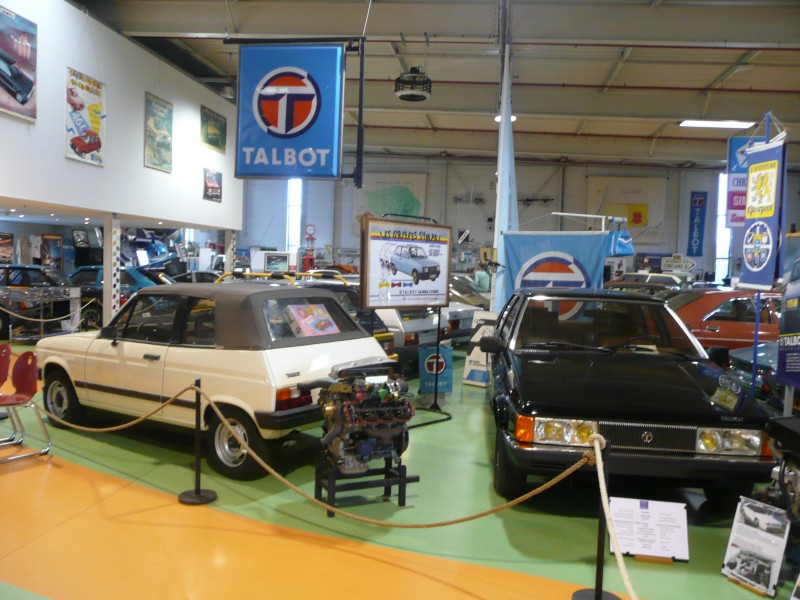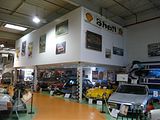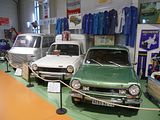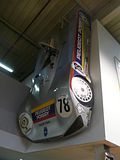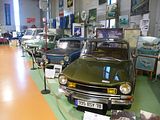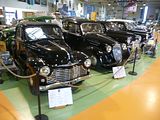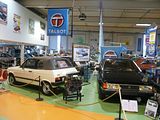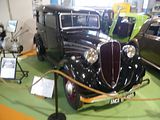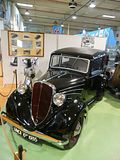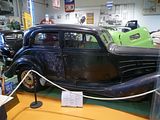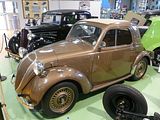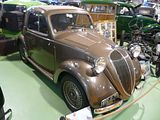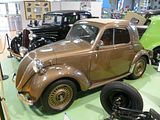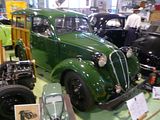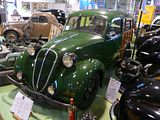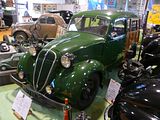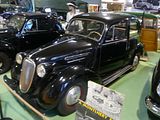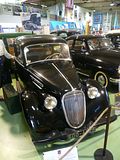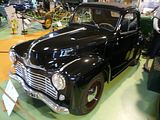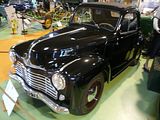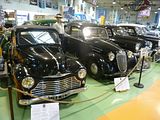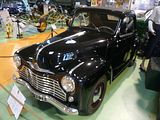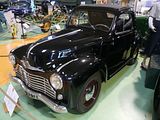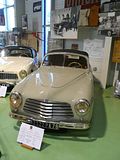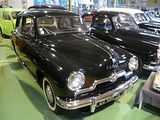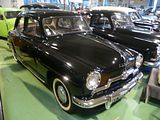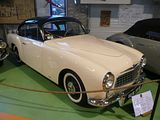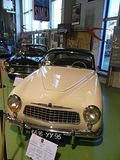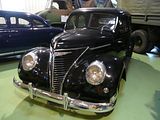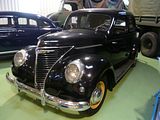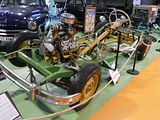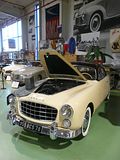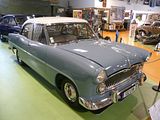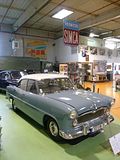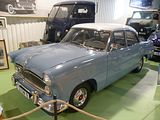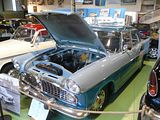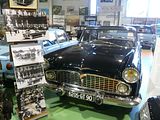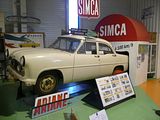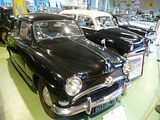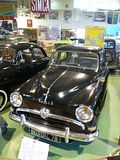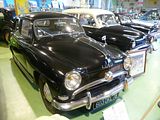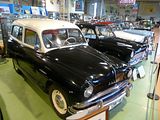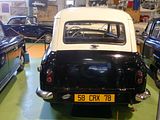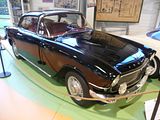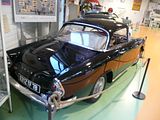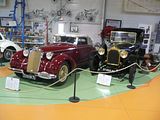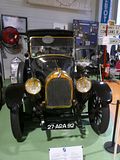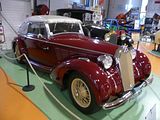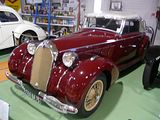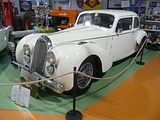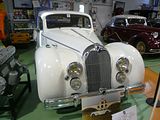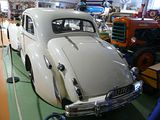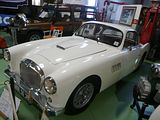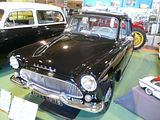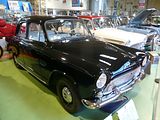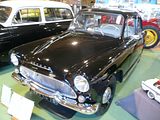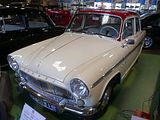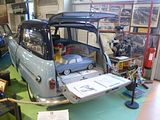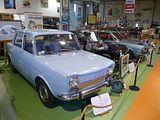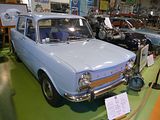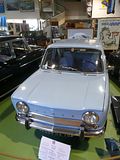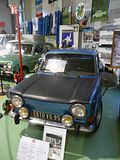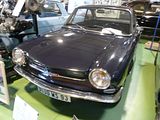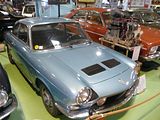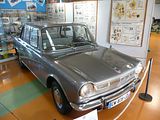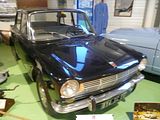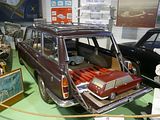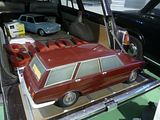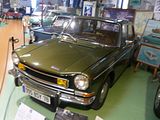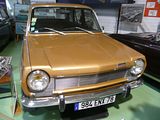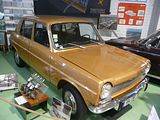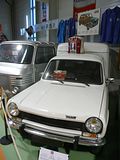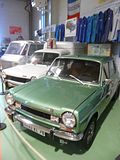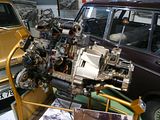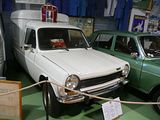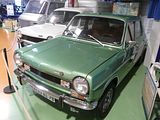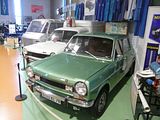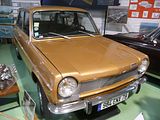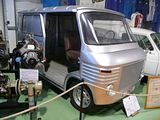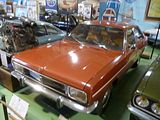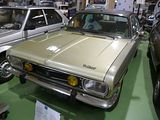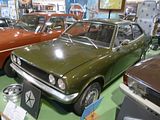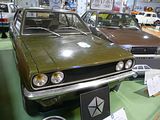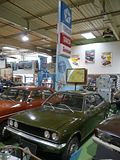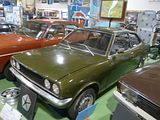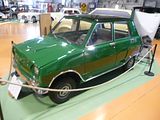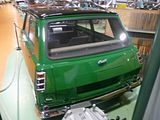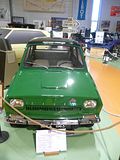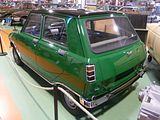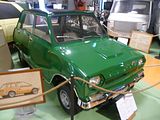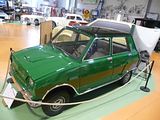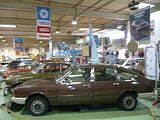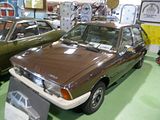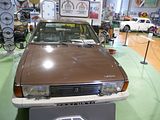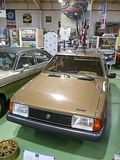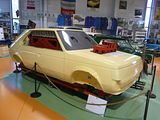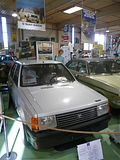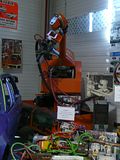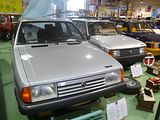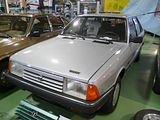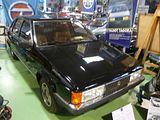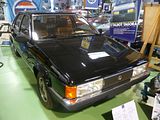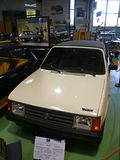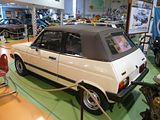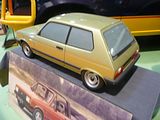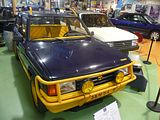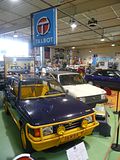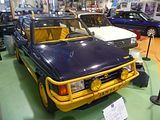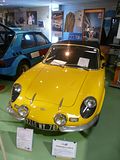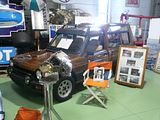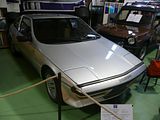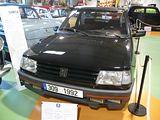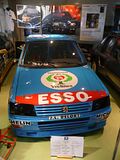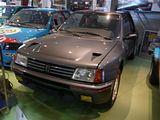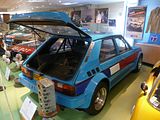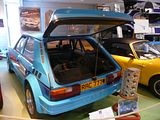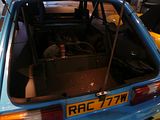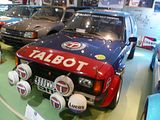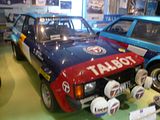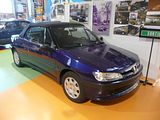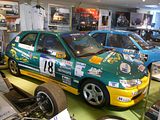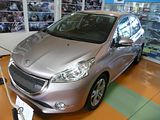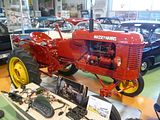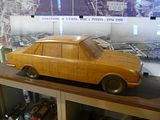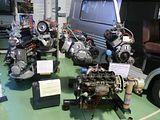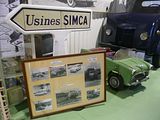It’s amazing just what you can find these days, thanks to the power of Google. But even by using various search arguments to discover car museums in places that I am definitely, or planning to attend, and following links into all sorts of side topics, I’ll confess that I’d never come across this particular collection. It was an article in the November 2013 edition of Classic and Sports Car which brought it to my attention. Intrigued by what looked like the world’s most comprehensive collection of Simca cars, I put it on the list of places to visit, and as Poissy, where the collection is located, is in the western suburbs of Paris, connected by RER train to the city centre as well as being just off the A13 and A14 autoroutes, it did not look as if it should be too hard to pay a visit. Hardest thing, actually, is that the collection is only open on Monday afternoons, Saturday mornings and afternoons, so you have to time a visit accordingly.
The Collection de l’Aventure Automobile à Poissy (CAAPY) celebrates French car manufacture through the eyes of this Parisian plant, which opened in 1938. Since then it has built Fords, Simca, Chrysler/Talbot and now it churns out Peugeots and Citroens from its modernised facilities. Not surprisingly, the focus of the collection is on Simca, a once proud French marque that for a while built the best selling car in France, but which has fallen into relative obscurity. The museum is located inside the factory complex. Not the main site which is very obvious as you arrive in the centre of Poissy, but at a second site the other side of the river. On a Saturday, you need to go up to the entrance gate, and then press a buzzer to request access. The massive gate slides back, and you can drive in. The museum is located in a separate building on the left. I parked up, went in and the place seemed deserted. Then I could hear voices and after a couple of minutes someone arrived and then said he would find a guide. Moments later, an older gent arrived. and he then took me round the museum, explaining what we were looking at, and providing lots of the history of the plant, and the products. Luckily, my French is good, as that is all he spoke, and I was able not only to understand what he said, but to ask questions. Tour over, he then said I could stay and take photos, which I duly did. Here’s what was on show and what I learned.
Simca had been set up in November 1934, to assemble Fiats under licence. This venture has its origins in things which happened some years earlier. An Italian called Ernesto Teodoro Pigozzi was active in the automotive business in the early 1920s when he met Fiat founder, Giovanni Agnelli. They began business together in 1922 with Pigozzi acting as a scrap merchant, buying old automobile bodies and sending them to Fiat for recycling. Two years later Pigozzi became Fiat’s General Agent in France, and in 1926 SAFAF (Société Anonyme Français des Automobiles Fiat) was founded. In 1928, SAFAF started the assembly of Fiat cars in Suresnes near Paris, and licensed the production of some parts to local suppliers. By 1934, as many as 30,000 Fiat cars were sold by SAFAF. But selling Italian cars in France was costly, and the French, even then, preferred a product made in France. The solution to this was SIMCA (Société Industrielle de Mécanique et de Carrosserie Automobile) a French company, founded in late 1934 by FIAT, when Fiat bought the former Donnet factory in the French town of Nanterre. Pigozzi, who took henceforth a French form of his name, Henri Théodore Pigozzi. The first cars produced were Fiat 508 Balillas and Fiat 518 Arditas, but with Simca-Fiat 6CV and 11CV badges. This is one of the Simca 6CV models.
The only example of the Simca 11CV, the Fiat 518 Ardita based model, in the collection is this 1937 model, the true barn find, awaiting a restoration.
The first two models were followed during 1936 by the Simca Cinq, named not because it was a 5CV car, as it was not, but from the first digit of the engine capacity of 570cc. This was a version of the Fiat Topolino. Announced in the Spring, the little car only became available for sale from October 1936. This is one of those early cars.
The Huit, an 8CV version of the Fiat 508C-1100, appeared in 1937. This had the same 1100cc engine as had been in the 6, but was a more modern car with a 4 speed gearbox, instead of the more common 3, independent front suspension and four doors without a central pillar. Production of the 6CV and 11CV stopped in 1937, leaving the 5 and the 8 in production until the outbreak of World War II. The firm nevertheless remained closely connected with Fiat, and it was not until 1938 that the shortened name “Simca” replaced “Simca-Fiat”, by which time the badge had been changed to resemble a swallow, and the slogan “appetite of a bird”, which was meant to indicate the range’s fuel economy potential had been adopted. The wooden rear body on this Van version was a tax ruse.
Of the businesses that emerged as France’s big four auto-makers after the war, Simca was unique in not having suffered serious bomb damage to its plant. There were persistent suggestions that Henri Pigozzi’s close personal relationship with the Agnelli family (which owned Fiat) and Fiat’s powerful political influence with the Mussolini government in Italy secured relatively favourable treatment for Simca during the years when France fell under the control of Italy’s powerful ally, Germany. Despite France being occupied, Simca cars continued to be produced in small numbers throughout the war. Following the 1944 liberation, the company’s close association with Italy became an obvious liability in the feverish atmosphere of recrimination and new beginnings that swept France following four years of German occupation. Nevertheless, shortly after the liberation the Nanterre plant’s financial sustainability received a boost when Simca won a contract from the American army to repair large numbers of Jeep engines. On 3 January 1946 the new French government’s five year plan for the automobile industry (remembered, without affection, as the Pons Plan) came into force. Government plans for Simca involved pushing it into a merger with various smaller companies such as Delahaye-Delage, Bernard, Laffly and Unic so as to create an automobile manufacturing combine to be called “Générale française automobile” (GFA). With half an eye on the Volkswagen project across the Rhine, the authorities determined that GFA should produce the two door version of the “AFG”, a small family car that had been developed during the war by the influential automobile engineer, Jean-Albert Grégoire. Grégoire owed his influence to a powerfully persuasive personality and a considerable engineering talent. Regarding the future of the French automobile industry, Grégoire held strong opinions, two of which favoured front-wheel drive and aluminium as a material for car bodies. A few weeks after the liberation Grégoire joined the Simca board as General Technical Director, in order to prepare for the production of the AFG at the company’s Nanterre factory. For Simca, faced with a determinedly dirigiste left-wing French government, the prospect of nationalisation seemed very real. Renault had already been confiscated and nationalised by the government at the start of 1945. Simca’s long standing Italian born Director General, Henri Pigozzi, was obliged to deploy his very considerable reserves of guile and charm in order to retain his own position within the company, and it appears that in the end Pigozzi owed his very survival at Simca to the intervention with the national politicians of his new board room colleague, Jean-Albert Grégoire. In return, Grégoire obtained the personal commitment of the surviving Director General to the production at Nanterre of his two-door AFG. The four door equivalent of the AFG went into production, little changed from Grégoire’s prototype, as the Panhard Dyna X. It was a car designed by an engineer, and Pigozzi thought it ugly. In trying to make it more appealing to the style conscious car buyers who, it was hoped, would appear in Simca showrooms once the economy picked up and government restrictions or car ownership began to be relaxed, Simca designers took the underpinnings of the Grégoire prototype and clothed it with various more conventionally modern bodies, the last of which looked uncannily similar to a shortened Peugeot 203. This “Simca-Grégoire” performed satisfactorily in road tests in France and around Turin (home town of Fiat who still owned Simca), and by September 1946 the car was deemed ready for production. But Pigozzi was still cautious. He had little enthusiasm for the gratuitously unfathomable complexities involved in producing a mass-market front-wheel drive car. The experience of the Citroën Traction Avant, which had bankrupted its manufacturer in the mid-1930s, was not encouraging. Pigozzi therefore applied to the (at this stage still strongly interventionist) government for a far higher level of government subsidy than the government could contemplate. Both the “Simca-Grégoire” project and the government’s own enthusiasm for micro-managing the French automobile industry were by now running out of momentum. Sensing that there was no prospect of putting the “Simca-Grégoire” into production any time soon, General Technical Director Grégoire resigned from the company early in 1947. Meanwhile, at the first Paris Motor Show since the end of the war, in October 1946, two models were on display on the Simca stand, being the Simca 5 and the Simca 8, at this stage barely distinguishable from their pre-war equivalents. The cars were facelifted in 1949, with a new bonnet and grille, and following the US trend, a column gearchange. Shown here is a 1951 Simca 8 model.
A new car arrived in 1948, the Simca 6, a development of the Simca 5 which it would eventually replace, and featuring an overhead valve 570cc engine. The Simca 6 was launched ahead of the introduction of the equivalent Fiat. This is one of those 1948 cars. 500 cars were made that year, 10,000 the following and a further 5000 in 1950, after which production ceased. The 6 was a two seater, and this was not appealing to many customers, so Simca set about developing larger cars for their future range.
That said, the next model to appear was also a two seater. The Simca 8 Sports originated as a coupé version of the Simca 8, but with the arrival of the Aronde the Simca Sport acquired a new grille in October 1951, and six months later it gained an extra 20 mm (0.8 in) of wheelbase, from 1952 sharing its 2,440 mm (96.1 in) wheelbase with the Aronde as well as its (at this stage) 1221cc (7CV) engine. This coincided with the loss of a separate chassis, and from this point, the Sport used an elegant monocoque body. The new monocoque bodied car was offered only as a two-seater hardtop coupé, there being for the time being no replacement for the former Simca Sport cabriolet. In October 1952 a cabriolet version of the now chassisless Simca Sport was exhibited, but the cabriolet version only entered production more than two years later in the Spring of 1955, presumably reflecting the challenges involved achieving sufficient structural rigidity in a slim and shapely cabriolet body, without incurring an excessive weight penalty. The Simca Sport would continue to share its engine and other technical components, as well as its wheelbase, with the Aronde until its withdrawal in 1962. It became increasingly expensive and correspondingly rare. Although its origins predated those of the Simca Aronde, the Simca Sport is now usually presented as a low volume stylishly rebodied version of the Aronde. 3400 cars were made during a 12 year production life. On show was one of the early ones as well as a later Plein Air model.
The French economy in this period was in a precarious condition and government pressure was applied on the auto-makers to maximise export sales. During the first eight months of 1947, Simca exported 70% of cars produced, placing it behind Citroen (92% exported), Renault (90% exported), Peugeot (87% exported) and Ford France (83% exported). In the struggle to maximise exports, Simca was handicapped by the fact that it could not compete with its principal Italian shareholder, Fiat. The solution was to develop cars of its own, rather to rely on modified Fiats. The results were seen when in 1951, Simca launched the Aronde, the first model not based on a Fiat design. Taking its name from the old French word for “swallow”, as Simca’s badge was a stylised representation of this bird. Initially only a few hundred pre-production cars were distributed to carefully selected “guinea-pig” buyers, and the full production version was finalised only in time for the Paris Motor Show, becoming available for sale in October 1951. The full production version incorporated various detailed changed when compared to the pre-volume production cars, including a changed material for the seat covers and a moulded plastic dash-board which at the time appeared very modern when compared to the metal dashboard on the Aronde’s most obvious competitor, the Peugeot 203. A few months later, at the start of 1952, space was found to position the battery under the bonnet: in the original cars the battery was stowed under the front seat. The Aronde was fitted with a front-mounted 1221 cc 44.5 bhp engine from the previous Simca 8, fuel feed being provided by a Solex 32 carburettor. Power was delivered to the rear wheels via a traditional four-speed manual gear box incorporating synchromesh on the top three ratios. The car had independent suspension at the front using coil springs, with a live axle at the rear, suspended using semi-elliptic leaf springs. Hydraulically operated 9.85 in (250 mm) drum brakes were used all round. The only body style offered at the October 1951 launch was a four-door saloon, but other configurations very soon became available such as the three-door estate (branded initially as the “Aronde commerciale” and later as the “Châtelaine”) with a horizontally split tailgate. There was also a van, called the “Messagère”, and a “commerciale semi-vitrée” – part panel van and part estate – became available in 1953. Of more interest to collectors is the two-door coupé coachbuilt by Facel. The Facel-built coupé was replaced for 1953 by a coupé based on the saloon Aronde body, called Grand Large, featuring a large three piece wrap-around rear window and a “pillarless” side window effect when both side windows were wound down.
A two-door cabriolet conversion, prepared by the coachbuilder Figoni, was presented to the public for the 1953 model year in a display involving ballerinas, but it proved impossible to confer sufficient structural rigidity on this car without unacceptable cost and weight penalties, and Figoni’s Aronde cabriolet was never produced for sale.A single coupe model by Figoni was also produced and this is that car.
Buoyed by the success of the Aronde, and with additional business following the 1951 acquisition of French truck maker Unic, Simca was snapping at the heels of France’s “Big Three”. Pigozzi’s ambitions did not stop there, though, and he continued to look for further ways of expanding the manufacturing operations of his Simca company. At the same time, Ford was seeking to divest itself of its French subsidiary, Ford SAF, and the large factory in Poissy, where it had been manufacturing cars since 1946. The construction of the Poissy plant was the project of Maurice Dollfus, Ford’s dynamic boss in France. In 1932 governments had responded to economic contraction by raising tariff barriers and Ford had responded to the need to source vehicles locally by entering into an agreement, in 1934, with the Strasbourg-based Mathis company to produce Ford-designed cars, which would be branded as Matfords, in an extended Strasbourg plant. Ford brought cash to the deal and a fractious partnership ensued, Mathis having found themselves obliged to abandon production of their own cars in October 1934. For Dollfus the Poissy plant, commissioned in 1938, would provide a route away from the by now bitterly litigious Matford relationship. Construction began on a large 240,000 m2 site bordering the River Seine in Poissy at the start of November 1938 and progressed remarkably rapidly, with the plant formally completed on 1 May 1940. Located a short distance downstream from Paris along the fully navigable River Seine, Poissy was near to Asnières, which was home to Chausson, at that time a car body producer and principal supplier to Ford France. The site was also adjacent to the main railway line connecting Paris with Le Havre.The plant became operational in the late Spring of 1940 and there was therefore very little time in which to produce anything before the débacle of May 1940. On 14 June 1940 Poissy was occupied by the German Army: under conditions of occupation the plant concentrated on light trucks. As the war dragged on there was a move, in 1943, to crate up Ford’s newly completed Poissy plant for shipment to the company’s Cologne location, but this was blocked, apparently due to the intervention of a recently resigned but still influential former Vichy government minister called François Lehideux. Poissy was liberated by the Americans on 26 August 1944 after several days of bombardment and civilian casualties. Ford’s boss, Maurice Dollfus was promptly arrested on suspicion of collaboration and transferred to Drancy. However, his release came quite quickly and the plant switched to supporting the allied war effort. Initially the government mandated Poissy to produce the light trucks that it had produced before the war, then in 1946 production commenced of the Ford F698W 5 ton truck known as the “Poissy”. Also in 1946, Poissy reverted to producing the smaller engined 2,225 cc V-8 engined Matford based model, albeit with improved suspension and brakes. The car was known in France as the Ford 13CV, although subsequently it was also called more formally the Ford F-472 and, after the first 300 had been produced, the Ford F-472A. The 4,270 cars produced in 1947 fell well short of Ford’s ambitions for the new plant ten years earlier, but with basic materials in short supply and customers short of money, in the late 1940s none of the French auto-makers experienced a rapid return to pre-war volumes.
The immediate post-war years were characterised by industrial unrest, and Ford’s Poissy plant was badly affected. Nevertheless, in October 1948 at the Paris Motor Show, the car that had originally been designed as a potential Mercury model, but then judged too small for the North American market made is debut, christened the Ford Vedette, still powered by the company’s familiar V8 2158cc engine. This quickly became Poissy’s principal model and during the early 1950s it certainly sold better than the aged Ford F-472A had. Nevertheless, François Lehideux who took over from Maurice Dollfus in January 1950 was known to be dissatisfied with aspects of the new car, many feeling that the car had been rushed to market, and lots of problems soon became evident, including a less than rigid chassis, and cooling issues. A hastily revised model was much better, but sales volumes remained disappointing. Although the engine was produced in-house and final assembly took place at the Poissy plant, other components and sub-assemblies were bought in which was believed to make production vulnerable to supplier problems. Scope for improvement was limited by shortage of investment cash and the limited market for cars with engines above 2 litre in size in a country where the tax regime heavily penalised larger engines. Nevertheless, a new V8 model for Ford of France was pencilled in for 1954.
Although the Vedette was the principal offering from Ford SAF, there was a more costly range topper offered as well, the Comète. Intended as the luxury model in the range, the Comète’s bodywork was built by FACEL, who later produced the better-known Facel Vega luxury cars under their own name. The original engine was a 2.2 litre V8 produced by Ford SAF of French design, also used in the Ford Vedette, with a Pont-à-Mousson 4-speed manual transmission fitted. The original model, launched in 1951, had a single horizontal bar across the grille with a chromed shield or bullet in the centre, somewhat similar to contemporary Studebaker products, among others, with steel wheels and chromed hubcaps. A larger and slightly more powerful 4 cylinder car was available for 1952, but things really changed from the start of 1954, when a new “Monte-Carlo” model appeared with the 3,923 cc V8 engine normally fitted to Ford trucks. This engine, befitting its truck heritage, delivered 105 hp with plenty of torque. Performance was much improved, but the new engine did not endear itself to buyers of the car having a “truck engine”, The engine’s large displacement meant that its taxed horsepower rating imposed by the French government was 22CV, giving a high road tax in a country where government taxation policy, especially after 1948, was high for cars with engine sizes above 2 litres. This new model was fitted with wire wheels, a fake hood scoop, and a typical for the time Ford egg-crate grille, consisting of vertical and horizontal equally spaced bars. The French called this grille a “coupe-frites”: a “french-fry cutter”. This is one of the Monte Carlo models.
The strikes that afflicted Ford’s Poissy plant, and the poor industrial relations tradition of Renault’s plant at nearby Billancourt did little to reassure Ford about the future direction of the French economy, and it became known that Ford were looking to sell their French manufacturing business, of which the Poissy plant was the principal fixed asset. Pigozzi took a different view, and with a new product about to be launched, that would be an addition to the Simca range, and plenty of space for expansion in the Poissy plant, so in July 1954, he made the bold move of buying Ford’s French operation, which gave Simca the manufacturing plant at Poissy and the new V8 Vedette range, thus catapulting Simca into the Number 2 spot in France, behind nationalised Renault. The new cars appeared at the Paris Motor Show in October 1954 on the Ford France stand, but there was no mention of the Ford name on the covers of the brochures offered to potential customers. The name “Ford” appeared just once, in very small print, on the final page, presumably in order to avoid confusing customers who would be expected to call the cars “Simcas” from 1 December 1954, the date set for the formal hand-over of the business. In export markets the name change was less immediate, and even in adjacent Belgium, in January 1955 at the Brussels Motor Show the cars were still appearing on the stand of the Belgian Ford importer, sharing the space with models imported from Ford of Britain. Indeed, the Vedette range was still marketed under the Ford brand in some markets, including the Netherlands and Germany, until 1956.
The new, modern Vedette, was a four-door saloon body of “American” style, much like the contemporary British Fords or Vauxhalls. The car was powered by an unusually small 2351 cc sidevalve V8 engine called Aquillon in France, derived from Ford’s Flathead engine family, the dimensions of which put the car into the “13 CV” French tax class. Equipped with a two-barrel Zenith-Stromberg 32NX carburettor, it produced 75 to 84 hp Power was transferred to the rear live axle through a three-speed manual transmission with column shift. The Vedette had MacPherson strut independent front suspension and drum brakes on all four wheels. As with the Aronde, Simca marketed different trim levels of the Vedette under different model names, this time with references to the grand period of baroque in French history. The basic version was called the Simca Vedette Trianon, the mid-level was the Simca Vedette Versailles and, at the top of the range, the Simca Vedette Régence. An option on all versions was a large glass moonroof that slid into the roof, called Vistadome. As the new model caught on, Simca was able to increase production from the 150 daily achieved during Ford’s ownership of the factory to 250 cars a day. This is one of the 1954 Versailles cars.
Pigozzi maintained a schedule of year-to-year model revisions, much like US manufacturers. For 1956, an estate version called the Simca Vedette Marly joined the line-up and the whole range was revised. A new license plate holder was added to the front bumper and the rear license plate now concealed the fuel tank filler. A peculiar addition was a pedal-operated windscreen washer, while other more ordinary changes included a second odometer, also known as a ‘trip meter’, for measuring partial distances. The Versailles and Régence were made even more comfortable with the addition of central armrests (Versailles in the rear only, Régence in front and rear), while the Trianon was simplified, losing bumper guards and chrome windscreen decor. In 1957, an option of the Gravina automatic clutch was added, along with better brakes and more direct steering. The Trianon regained the chrome decor around the windscreen, while the other models acquired slimmer tail lights and the front ornament was replaced with a new design. Bumper-mounted V8 badges were introduced but, although the whole range featured the same V8 engine, the new badges appeared on the bumpers of only the Régence and Marly.
After three years in production, the Vedettes were given new names and a new, elongated body, with a more ornate front end and large tailfins, making the cars even more American-looking than before. This was part of a styling trend shown by most large European cars of that period, which were, to some extent, inspired by American styling, as tailfins appeared on the Pininfarina styled Peugeots, Fiats and BMC models, Fords and even Mercedes-Benz cars of that era. The engine was uprated to 84 hp (now called Aquillon 84) but the fiscal qualification of the car remained unchanged. Using the new body, the Versailles was replaced by the Simca Vedette Beaulieu and the Régence by the Chambord, while the estate retained the Vedette Marly name. This is a Chambord.
The three-year-old body of the previous Vedette nevertheless continued in production but it lost its V8 2.4-litre engine. In April 1957, fitted with the 1.3 L Aronde engine, the old body now clothed a new model in the Simca range, the Simca Ariane. Later, in October 1957, a V8 version of the old bodied car, with the Aquillon 84 engine, and badged as the Ariane 8, joined the range, replacing the Trianon. 1959 brought a new option, the Rush-Matic automatic transmission, which featured two modes: Rush (fully automatic) and Road (manual gear selection). The same year, assembly of the Vedette started at Simca do Brasil. Also during 1959, a new top-of-the-line model joined the Vedette range, the Présidence, featuring a luxurious interior, a radiotelephone (a European first) and a continental kit. French coachbuilder Chapron built two 2-door Présidence convertibles for a governor of one of the French colonies. Chapron had another order the next year, to build two four-door convertibles for the French President Charles de Gaulle.
The Beaulieu was dropped in autumn 1960, but the other models remained unchanged until the 1961 model year, when they received new seats, new chrome decor, and the engine was fitted with a new anti-vibration crankshaft. French production of the V8-engined cars ended in the summer of 1961, by when 173,288 had been produced, although a Simca Chambord was exhibited at the Paris Motor Show in October of that year, suggesting that Simca still had some stock of the cars to clear. The small-engined 4-cylinder Ariane, of which 166,363 were produced, survived until 1963.
The second-generation Aronde, known as the 90A, debuted in October 1955. Externally there was an updated body, with restyled front and rear ends. A very slight lengthening of the car at the back made it possible to position the spare wheel under the floor of the boot which allowed for a substantial increase in usable luggage capacity. The new Aronde was now powered by the ungraded and newly named 1290 cc Flash engine. The unit retained the 75 mm cylinder stroke of the previous engine, but the cylinder bore was increased to 74 mm. The Solex 32 carburetter was unchanged but a raised compression ratio provided for a small increase in claimed maximum power which, for the models as displayed at the motor show in October 1955, now given as 45 hp at 4,500 rpm or 48 hp at 4,800 rpm (and more in some low volume more highly tuned versions). New trim levels, marketed as Elysée and Montlhéry appeared. The estate (“Commerciale”) and van (“Messagère”) remained available, with a 45 PS version of the 1.3 litre “Flash” engine. They received the 90K modelcode. In January 1957, the 500,000th Aronde was made, and the cars were now exported even to the USA.In October 1957, two new versions, both with bodies by Facel joined the Aronde range: the Océane, a 2-seater cabriolet, and Plein Ciel, a 2-seater coupé, the latter of which is shown here.
Poissy was modernised in 1958 and became the firm’s flagship factory. Things were looking good, and Simca went from strength to strength. So much so that in 1958, they bought the remains of the Talbot-Lago company, so it seemed fitting that a number of the lovely cars from this once proud French marque should also be represented.
Oldest car in the museum is this 1923 Talbot. My guide told me that it does get taken out on the road, but it is somewhat “interesting” (that was the word he used!) to drive, as it only has rear wheel brakes, so stopping it is not something that you do quickly.
The Anglo-French Sunbeam-Talbot-Darracq combine had collapsed in 1935. The French Talbot company was acquired and reorganised by Venetian-born engineer Antonio Lago (1893–1960) and after that, the “Talbot-Lago” name was used internationally. Home market the cars still bore the Talbot badge that they had carried since 1922, which was when, in France, the “Talbot-Darracq” name had given way to “Talbot”. For 1935, the existing range continued in production but from 1936 these were steadily replaced with cars designed by Walter Becchia. Among them were a range of Sporting Cars which started with the Talbot “Baby-15”, mechanically the same as the “Cadette-15” but using a shorter slightly lighter chassis. The Sporting Cars range centred on the 6-cylinder 2,996 cc or 3,996 cc (17 or 23CV) Talbot “Baby” and also included the 3,996 cc (23CV) 23 and sporting Lago-Spéciale and Lago-SS models, respectively with two and three carburettors, and corresponding increases in power and performance. The most frequently specified body for the Lago-SS was built by Figoni et Falaschi and featured a particularly eye-catching aerodynamic form. Lago was an excellent engineer who developed the existing six-cylinder engine into a high-performance 4-litre one. The sporting six-cylinder models had a great racing history. This one of the cars from that era, a 1939 Talbot T150 C, 1 of just 63 such cars produced, it is the star of the collection. It belongs to a private collector, who keeps it at Poissy.
The T26 Grand Sport (GS) was first displayed in public in October 1947 as a shortened chassis. Just 12 were made during 1948. Noted for its speed thanks to an engine which produced 170 hp, and adapted in the Lago Record to provide 190 bhp or, later, 195 bhp in the GS, a top speed of around 200 km/h (124 mph) was claimed, depending on the body that was fitted.The car was built for either racing or luxury and benefited directly from Talbot’s successful T26C Grand Prix car. As such it was expensive, rare and helped Louis Rosier with his son to win the LeMans 24 Hour race in 1950. The GS replaced the Lago-Record chassis which was named for its remarkable top speed. Having a 4.5-litre inline-6 aluminium cylinder head and triple carburettor from the T26 the Grand Prix cars, the GS was one of the world’s most powerful production cars. Chassis details were similar to the Grand Prix cars, but it was longer and wider. It came it two wheelbase lengths -104 and 110 inches (2,800 mm). Almost all the Talbots sold during the late 1940s came with Talbot bodies, constructed in the manufacturer’s extensive workshops. The T26 Grand Sport (GS) was the exception, however, and cars were delivered only as bare chassis, requiring customers to choose bespoke bodywork from a specialist coachbuilder. The GS was a star turn in a dull world and coachbuilders such as Saoutchik, Franay, and Figoni et Falaschi competed to trump Talbot’s own designers with elaborately elegant bodies.
At the 1954 Paris Motor Show, Talbot-Lago presented their last new engine: the new four-cylinder still had the typical twin laterally mounted camshafts, although it was upgraded to five main bearings. The new 120 PS 2,491 cc engine was called the T14 LS, but it did not have a car to go in until May 1955 when the Talbot-Lago 2500 Coupé T14 LS was finally presented. In addition to its intended use for a road going car, the engine’s size, precisely conforming to the racing engine category of 2.5-litre engines without compressors, hint at Tony Lago’s other ambitions for the new power unit. The first car had all-aluminium bodywork, but later cars used more steel. 54 of these coupés were built, but they proved hard to sell – the stylish bodywork couldn’t quite hide the thirties’ underpinnings. The engine developed for the car by Talbot proved unacceptably fragile. Lacking the resources to engineer the necessary improvements, for 1957 Talbot-Lago had to resort to buying in an engine. They chose the V8 2580 cc light-metal unit made available by BMW, albeit with the bore diameter slightly reduced, to 72.5 mm, which gave rise to a 2476 cc engine displacement, positioning the car (just) within the 14CV car tax band. Reflecting the company’s export plans, Talbot now rebranded the car as the “Talbot Lago America” and (finally) came into line with other French automakers by placing the driver on the left side of the car. Market response remained lukewarm, however, and only about a dozen of the BMW-powered Talbot Lago Americas were produced. It was now, in the early summer of 1958, that Tony Lago decided to accept an offer from Pigozzi, for the sale of the Talbot brand to Simca. With the sale of the business to Simca, the new owners found themselves with the final handful of the Talbot Lago Americas, which were still awaiting engines. There was now no question of Simca being permitted, or wishing, to produce cars with BMW engines, and the only solution available was to fit the last batch of cars with Simca’s own 2351 cc V8. This engine had its roots in 1930s Detroit, and was originally provided by Ford to give the (then) Ford Vedette produced by their French subsidiary a flavour of the driving experience offered by an unstressed US style V8 sedan. It was by no stretch of the imagination an engine for a sports car, and even with a second carburettor produced only 95 bhp, as against the 138 bhp of the BMW-engined cars from the previous year’s production. Claimed top speed was now reduced to 165 km/h (103 mph) in place of the 200 km/h (124 mph) listed the previous year.In addition to installing their V8 engine, Simca replaced the laterally sliding windows in the doors of the final cars which now wound down into the door in the conventional manner: the change also involved adding front quarter lights / quarter windows at the front end of each door. At the 1959 Paris Motor Show a stand had been booked for what was by now the Simca-Talbot brand, but a late decision was taken not to exhibit a Lago America, and the stand was instead given up to a hastily constructed “motorshow special” prototype of which, after the motor show, nothing more would be heard. The Simca-engined cars, still bearing a list price in excess of 2,000,000 Francs, proved hard to sell, with just five of the Simca-powered car sold according to one source. No further cars were produced once the final batch of cars from the Talbot production era, having received their Simca engines and window modifications, had been disposed of.
This is one of the “Bacalan” Arondes. Intended to be the new 1959 model, these featured a restyled front and rear on the old centre section. At the pre-production stage, Pigozzi rejected the design, which was then remodelled with a flatter roofline to become the definitive P60. The pre-series cars were kept in a depot on the Quai Bacalan, near Bordeaux, and offered to staff at reduced prices. Only 150 found homes, the remainder were eventually exported to Hungary and Czechoslovakia.
This is the production version of the third generation Aronde. Presented at the Paris Motor Show in October 1958, the P60 version came with a new modern-looking body. The 2,440 mm (96.1 in) wheelbase was unchanged and, apart from a slightly lowered roof-line, the central portion of the body was still broadly similar to that of the original 1951 Aronde, but the discrete tail-fins and rear lights were restyled as were the headlights, set on either side of a larger grille at the front. Mechanically little had changed: more innovative was the wide range of versions and permutations now offered, with customers able to choose from a range of engines offering four different levels of power output (40, 45, 47 or 57 hp) and an options list that even included leather upholstery and a “Simcamatic” clutch. In line with the manufacturer’s determination to offer customers more choice, the P60 was offered with various names. The following cars all shared the same wheelbase and the same length/width footprint: Élysée was a 4-door berline with a 1290cc 48 hp engine; Grand Large was a 2-door “coach panoramique” pillarless saloon with the same engine; the Montlhéry was a 4-door berline with a 1290cc higher compression 57 hp engine; Monaco, a 2-door “coach panoramique” pillarless saloon with the 1290cc higher compression 57 hp engine and the Châtelaine, a 5-door estate/station wagon with the less potent 1290cc engine, retaining the body of the earlier Aronde 90A Châtelaine, but by 1960 a more luxurious estate version, branded as the Simca Aronde P60 Ranch, combined the new front end from the P60 with the back end of the previous generation of Aronde estates.
In 1958, the American car manufacturer Chrysler Corporation, which wanted to enter the European car market, bought the 15% of the Simca stocks that Ford had retained from the 1954 buy-out, in a deal which Henry Ford II was later reported as having publicly regretted. At this stage, however, the dominant shareholder remained Fiat, and their influence is apparent in the engineering and design of Simcas of the early 1960s. The Suez Crisis struck at the end of 1956, and the resulting fuel shortages placed the emphasis back on very small cars. Sales of the V8 Simcas recovered a little by the end of the decade, but production volumes never again approached those of 1956. Simca responded rapidly by adding to their range the Simca Ariane which was a big car with a small engine, also produced in Poissy, which during the ensuing six years clocked up over 160,0000 sales. However, by now the large car market in France was increasingly dominated by the Citroen DS which was in a lower car tax bracket than the V8 Simcas and had, after slow start, caught the spirit of the new age. The solution was to build a new small car, and that is what Simca planned. Poissy’s large site had always been underutilised, so there was plenty of capacity to build it, and even with projected volumes of over 100,000 cars a year, it was clear that Simca could build everything they needed and with capacity to spare, so in 1961, Simca sold the plant at Nanterre which they had occupied since 1934 to Citoren. After this Poissy was Simca’s only large scale production facility in France. Later that year, the brand new small car was launched, the Simca 1000, or the Mille. Following the trend for “bath tub” styling which was evident on the Chevrolet Corvair and NSU Prinz, this was a rear engined saloon car which had been intended to have a flat four engine, but which emerged with a conventional inline four. In fact, the origins of the Mille lie in Italy, a result of the still close relationship between Pigozzi and the Agnelli brothers at Fiat. In the mid 1950s, Fiat started to think about how to replace the popular 600. Something a little larger and more powerful than the current car, reflecting growing prosperity in Italy at the time, was envisaged, and two projects were run in parallel: “Project 119” was for a two door successor, building on the strengths of the current model, while “Project 122” was for a more radically differentiated four door successor. Although this work would have been a closely guarded secret to anyone outside the inner sanctum of Fiat’s Development Department t Pigozzi’s privileged relationship with the Agnellis opened even these doors, and during the late 1950s he took a particular interest in the Department. It became clear that Pigozzi’s intentions to extend the Simca range further down in the small car sector aligned closely with Fiat’s own “Projects 119” and “122”, intended to build a presence upmarket from the Fiat 600. Pigozzi obtained the agreement of the Fiat directors to select one of the six different rather boxy four-door clay models and mock-ups that then comprised the output of “Project 122” to be developed into Simca’s new small car. As he Fiat 600 continued to sell strongly, Fiat felt little sense of urgency about investing to replace it, and management evidently decided that a four door replacement for the 600 would represent too big a jump from the existing car, leaving Project 122, which underwent remarkably few changes once under the control of Pigozzi and Simca. It was not until 1964 when the fruits of “Project 119” became public with the launch of the Fiat 850. The Simca 1000 was launched at the 1961 Paris Motor Show, and Pigozzi got some early publicity by replacing 50 of the Simca Ariane taxis on the streets of Paris with the much smaller 1000 model, thus emphasising the roominess of the car, as well as making it very visible to a lot of people. Over the course of time, the 1000 was sold in a number of versions featuring different equipment levels and variations of the original Type 315 engine. In 1963 the poverty spec Simca 900 arrived; in spite of the name change it also had the 944 cc engine with 36 PS, but the 1000 now gained three more horsepower. In 1966 only the 900C was available, equipped with the more powerful iteration of the 315. In late 1968 the low cost Simca 4 CV (marketed in France as the Simc’4) appeared, powered by a 777 cc unit providing 31 PS, and very competitively priced. Power was later increased somewhat, to 33 PS. The 1000 engine was updated simultaneously, it was now called the type 349. At the top end of the range, the 1118 cc unit from the larger Simca 1100 was added for the 1969 model year (and indeed the Simca 1000 was marketed in the USA as Simca 1118). Finally, the 1294 cc “Poissy engine”, used in the bigger 1300, found its way into the little 1000 in the early 1970s. Apart from the standard manual transmission, some versions could be fitted with a three-speed semiautomatic developed by Ferodo. The car underwent a light facelift first shown at the 1968 Paris Motor Show, with new hubcaps, redesigned bumpers, bigger headlamps, and square taillights. The high-specification versions were offered in the British market with a walnut dashboard decor. In the model’s early years, the Italian tuner Abarth was offering modified versions of the 1000, and later Simca itself began offering a “Rallye” version, which helped boost the model’s popularity in the motorsport community. The Rallye was followed by the Rallye 1, the Rallye 2 and the Rallye 3 and these cars are much prized by collectors these days. In 1977, the model was revised for the last time, gaining the new names of 1005/1006 (depending on the specifications), to put it in line with the newer Simca 1307 and its derivatives. Production stopped in 1978 without a direct replacement.
The 1000 served as the platform for the 1000 Coupe, a handsome sports coupe that made its appearance in 1962. Conceived to raise the profile of the new 1000 internationally, and mindful of the precedent set by Renault with their (initially Frua bodied) Renault Floride, Simca had turned initially to Facel to discuss a joint project with Facel producing the bodies, but Pigozzi felt that Facel’s proposal lacked the necessary style and was considered unrealistic: there were also concerns that Facel’s parlous financial position might impact the project adversely. Simca then turned to Bertone and commissioned a coupe version of their new car. Bertone gave the job to a recently recruited young designer called Giorgetto Giugiaro and the car, having already been heavily trailed, was formally launched at the Geneva Motor Show early in 1962, though official French homologation for production only took place in November 1962 and customer deliveries did not begin until 1963. The style of the car was widely admired, but the cost of the Bertone built body made it difficult for the car to compete on price alone, while use of the standard 944 cc engine block from the Simca 1000 meant that performance did not live up to its racey styling. From the start Simca presented the Coupé 1000 as a separate model. The car was moderately successful, especially in France, selling 10,600 cars in 5 years.
In 1967, Simca upgraded the car to the more powerful 1200S Bertone Coupe that, with a horsepower upgrade in 1970, could reach the dizzying speed of almost 112 mph (180 km/h), making it the fastest standard production Simca ever built. When production ceased in 1971, it was revealed that around 25,000 of these cars had been made.
Next to appear was a family sized car, a replacement for the Aronde, the 1300 and 1500. Offered initially as saloon cars, an estate model was added to the range in 1964, and this car was notable for having a wind down rear window and drop down tailgate. Another clever feature was the ability to remove the boot floor, and fold down legs creating an instant picnic table for use outside the car. In 1966 the cars were revised, with a revised front end, longer tail for the saloon models, and upgraded trim and they took the names 1301 and 1501. Nicely finished, they proved quite popular, even in Britain, where a quirk of the conversion from the column gear change of left hand drive cars meant that the floor change had the gear positions in the mirror image of what you normally get. Rust has claimed almost all of them, so you rarely see one now.
In 1963 Chrysler increased their stake to a controlling 64% by purchasing stock from Fiat. Furthering their ambitions in Europe, in 1964 Chrysler bought the British manufacturer Rootes thus putting together the basis of Chrysler Europe. All the Simca models manufactured after 1967 had the Chrysler pentastar logo as well as Simca badging. That meant that when the next new model appeared, the very successful 1100 hatchback, it bore both badges. Slotting into the range between the 1000 and the 1300, this was a much more up to date car, with a transverse engine, front wheel drive, rack and pinion steering, independent suspension all round, and a folding rear seat and hatchback for added versatility. Following the initial 3 and 5 door Hatch models, Estate, Van and Pickup models were added to the range, and in the early 1970s, hotter models followed, with the 1204S and the 1100Ti, which it could be said were actually the first hot hatches, pre-dating the Golf GTi by some 4 years. The Simca 1100 became France’s best selling car, deposing the Peugeot 204 from the position, and it continued in production until 1981, long after the introduction of its replacement, the Horizon. Over 2.2 million of them were made, but sadly, very few survive.
This is an interesting prototype of a Simca 1100 based van which would have competed against the ageing Renault Estafette and the newly launched Ford Transit. It never made production.
On 1 July 1970 the company title was formally changed to Chrysler France. That meant that when the next new model came out, it had Chrysler badges. This was a large saloon, the 160/180 range. This was a joint effort from both sides of the Channel. Separate development projects had been underway in the UK and France to produce a large car, and Chrysler decided that these should be combined. The decision was taken to go ahead with the British C Car programme, but to develop two versions for both the UK and the French part of the concern. Chrysler funded a new plant along with a development centre for the Rootes Group at the Whitley plant, Coventry, where the development was continued. Roy Axe employed former Chrysler USA designer Curt Gwinn as project designer, and the C Car took a shape very similar to an enlarged version of Hillman Avenger. Initial designs were inspired by contemporary American Chryslers, with twin headlamps and a light bar in the rear.In 1970, however, Chrysler reviewed the programme once again and decided to trim it down to just one version, to be built in Simca’s Poissy factory in France, for all markets.The responsibility for the programme was then passed in turn to Simca (where it became known internally as “Simca 1800”), who gave the car a different front end with rectangular single front lamps, as well as stripping the interior of some features proposed by the Rootes Group team, such as genuine wood and leather and air conditioning. Much to the shock of the British engineers, the entire V6 engine programme was scrapped, even though £31 million of the £38 million of the programme budget had already been spent, and the tooling for the new engine was already being installed in the Rootes’ Humber Road factory.The car also ended up with more conventional coil sprung rear live axle and MacPherson struts in the front and a four-speed manual transmission (with an option of a three-speed automatic). It was launched at the 1970 Paris Show as the Chrysler 160, 160 GT and 180. In a fashion similar to Simca models, the designations referred to the displacement of the engines employed by the given version. The 160 employed the 1632 cc unit, while the 180 came with the 1812 cc one. A bit confusingly, the 160 GT came equipped with the larger engine.The 160 had 80 PS while the 160 GT and 180 had 97 PS. Only the 180 was offered for sale in the UK. This was an era when the Press tended to be positive about any new car, so trying to figure out what they really thought is not easy. The market soon showed what the public thought, though. Sales were disappointed, and the car was not received too well either in France or in the UK. Its mixed pedigree and exotic brand did not fit in well with the expectations of more nationalistic buyers and reviewers, and there was little that would make the car stand out among the crowd of similar cars, many of which already had an established position in the class. By 1976, with the number of cars sold in the UK not yet up to 10,000, British sales had settled down at the annual rate of about 2,000 which was seen to be below the company’s expectations, but UK sales were more impressive than those in France.In France, the sales of the Chrysler were so disappointing that the old Simca 1501 was offered again for 1974 (it remained in production sometime after the Chrysler’s launch for export markets mostly, in order to use up the remaining parts). Only in Spain was the car a success, and that is because once it had become apparent that the model was far less than a market hit, Chrysler decided to move the assembly lines from the Poissy factory to the Villaverde plant of its Spanish subsidiary, Barreiros. Barreiros had been assembling many Simca and Chrysler models previously for the protected Spanish market, but for the first time it would become the sole supplier of the entire model line for all markets. With the Spanish market of the 1970s effectively closed to vehicles produced outside Spain, its only real competitor was the Seat 132. The vehicle became reasonably popular in its new home market, and local coachbuilders even created estate and stretched versions of the car. The lineup remained for the most part unchanged in most markets, although the 160 was not offered in Spain, which in turn received a new diesel model, powered by the Barreiros 2.0-litre diesel engine (not offered in other European markets). Sales everywhere other than Spain stopped in 1980.
I was intrigued by this prototype, as it looked to me more like a Hillman Avenger-based car than a Simca. Called Coupe A, it was produced in 1970 and was a clear response to Ford’s Capri, but the idea went nowhere.
The stifling of creativity was clearly not new, as also on show was this, It is known as Project 936, and it dates back to 1963. A small car which was intended to take on the recently launched Mini, it remained a one-off prototype, but closer inspection reveals that it had plenty of innovative ideas on how to extract lots of roominess from a small and not bad looking body. Perhaps an idea before its time, when the concept was abandoned, the somewhat disappointed designer left Simca, and joined rival Renault and went on to create the big selling Renault R5. You can see distinct links between the 2 cars even though they were designed more than ten years apart.
Finally, in 1975, there was a new car. The 1307/1308 models, known as the Chrysler Alpine in the UK, seemed to be just what was needed, with a modern looking five door hatchback and plenty of space. When they went on to win the Car of the Year award, it seemed as if they could be poised to take on the might of the Big Players in Europe. Sadly, though, the funds had not been there to develop new engines, and these cars were saddled with the old, rattly and unrefined Simca units which undermined their credentials in the face of the all new Golf and Passat from VW, and the fact that they were front wheel drive was still a significant obstacle to breaking into the all important and ever so conservative British fleet market which was not even solved when Chrysler started to build the cars in Coventry as well as Poissy.
Another new model appeared in late 1977, the Horizon. A replacement for the long running 1100, this car was designed to meet the needs of customers on both sides of the Atlantic, with Dodge and Plymouth Omni versions offered to American buyers. This one also won the Car of the Year award, but it was also saddled with the same unrefined old engines in Europe (and strangled VW units with a power-sapping automatic box in America, which made them dog slow). The launch of the SX with a more powerful 1.5 litre engine and the new fangled trip computer did little to increase the sales appeal, and with a new front wheel drive Astra/Kadett and Ford Escort as well as VW’s Golf, it struggled even when the excellent 1.9 litre diesel – the best unit on the market at the time – went under the bonnet in 1982.
Chrysler had steadily extended their holding of the company to 77%, though even in 1971, Fiat retained a 19% share, but by now they had long ceased to play an active role in the business. Struggling financially with problems in the US domestic market, and not for the first time, the Americans extracted the maximum from Poissy and Simca with minimal investment, thus beginning a long and slow decline. Chrysler’s forced marriage of Simca and Rootes was not a happy one, and starved of the necessary investment on both sides of the Channel, Chrysler Europe collapsed in 1977 and the remains were sold to Peugeot in August the following year. The Rootes models, which were even older than the Simcas, were quickly killed off, and the Simca-based Alpine/1307 and Horizon soldiered on through the first half of the 1980s using the resurrected Talbot badge. During this time, there was some modernisation, and robots started to be used for part of the production process. This is an example of the very first one, which was commissioned in 1978 and used to aid assembly of the Horizon.
In 1980, a couple of new models appeared. The first of these, the Solara, was little more than a 1307/1308 with a boot. It was the last car to bear the Simca badge, though this was quickly turned into a Talbot, to match the rest of the range.
Later that year, a new executive saloon arrived, the Tagora. This car was doomed from the start. Designed prior to the Peugeot-Citroen acquisition, as a replacement for the long running 160/180/2 Litre, and objectively it was not a bad car, if a bit slab sided in its styling. But it went up in-house against the recently launched Peugeot 505 and flagship 604, against which it did not stand a chance. Sales started in May 1981, but they were slow, and the model was quietly killed after three years, with just 16,194 having been made.
One final Talbot arrived later in 1981, the Samba. Desperately needing a small car in the range, this hastily produced model was an adaptation of the far from new Peugeot 104Z, but enough was done to make it look different that it found some buyers, and the decision to add a Pininfarina styled Cabrio model to the range was certainly a good way of adding some interest to the range.
This Samba Capuccino is a one-off model which was built for the 1985 Turin Motor Show.
Simca never produced their own sports cars, but they did supply the engines to a now little known company called Chappe et Gessalin, mostly referred to as CG. This was a French car maker, founded in 1946, who produced a small number of complete cars in Brie-Comte-Robert, Seine-et Marne from 1957 until 1974. CG began by producing fibreglass bodies for DB and Alpine, but later produced cars similar to the Alpine but powered by Simca engines. The last racing CG, the CG-MC, was designed by Matra.
Mécanique Aviation Traction or Matra (Mécanique Aviation TRAction) was a French company covering a wide range of activities mainly related to automobiles, bicycles, aeronautics and weaponry. Owned by the Floirat family, the name Matra became famous in the 1960s when it went into car production in 1965 by buying Automobiles René Bonnet, with the first road car being the Djet. Matra Automobiles went on to produce racing and sports cars, the former enjoying much success. In 1970, they signed an agreement with Simca, which brought the two companies closer together and gave Matra access to the Simca engines and mechanicals which Matra could not afford to develop themselves.
In 1977, Matra presented the Rancho, a vehicle that we now see as way ahead of its time. This was effectively the first fashion-statement Crossover/SUV. Beneath the tough-looking glassfibre body were standard Simca 1100 mechanicals and front wheel drive, with noi option for AWD. Just under 58,000 were made in 7 years. Many thought it to be quite costly and the market was not really ready for recreational vehicles like this. Sadly, although the bodies did not rust, what was underneath did, and few survive. I think it is one of the coolest cars of the 1970s, so I was delighted to find one in the collection here. It deserves its place, as although the body for the Rancho was made by Matra in Romorantin, the mechanicals were produced in Poissy.
The Matra Murena was a 3-seat single row sports car with mid-engined rear wheel drive, produced from 1980 through 1983. Replacing the Bagheera, a similar vehicle resulting from the first fruits of the Matra-Simca cooperation, the Murena employed the base Bagheera structure, but substantial changes were made to address some of the concerns regarding the previous model. The car still had a steel spaceframe with body panels made of fibreglass-polyester, but to counter the rust issues plaguing the Bagheeras, the spaceframe was galvanized, the first production car to use galvanized steel for all chassis parts. This, coupled with the composite panels, made the car essentially immune to rust, except for the rear trailing arms of the suspension. The Murena also inherited the Bagheera’s mid-engined layout together with the sleek hatchback body shape, with the rear hatch allowing access to the engine mounted behind the passenger compartment, and a luggage area. The styling was all-new, though, and the body very aerodynamic for its time. A unique feature carried over from the previous model was the seating arrangement – all three seats were placed in one row, with the middle seat folding down to become an armrest when not in use by a passenger. The engine selection was different, however. The base model had a 1.6 engine, while the more powerful version employed the 2.2 engine that was also the base engine for the top of the range Talbot Tagora saloon. This engine was also available with the so-called “S-kit” that upgraded its output to 142bhp At first, this was a dealer-fitted option, but later it could be ordered straight from the factory. The standard carburation was via a single Solex downdraft carburettor, but S models had twin side draft carburettors. The car had good performance and handling. It was only available in left hand drive specification, although a very small number of right hand drive conversions were made. Production ceased when the Matra factory in Romorantin switched to production of the Renault Espace multi-people carrier.
Work was undertaken to produce new Talbot models for the mid 1980s, and pictures of a replacement for the Samba were seen, but, quite sensibly, the decision was taken to phase out the Talbot brand, focusing on Peugeot and Citroen models. That meant that the Poissy plant became 100% Peugeot, and the car which had been planned as the Talbot Arizona, a replacement for the Horizon, was given Peugeot badges and launched as the 309, although it did still have those tappety old Simca engines until late 1991. Those not withstanding, this was quite a decent car, and it sold reasonably well, but these days it has largely disappeared, forgotten in favour of its smaller relative, the 205. One thing I had never realised about this now largely forgotten hatch is that it shared its doors with the smaller 205. The model on display is one of the post 1991 facelift cars with the revised rear light clusters and a lower loading lip to the boot, seen in GTi form, a guise which many said made it a better car than the much loved 205 GTi.
A reminder of the 205 comes in the form of the iconic 205 Turbo 16. Produced so Peugeot could go Group B rallying, homologation requirements meant that Peugeot had to produce a minimum of 400 road going versions, and these were made here in Poissy.
This was not the first thought that Peugeot-Citroen had had of Group B rallying, as also on show is a unique Lotus-powered mid-engined Talbot Horizon which was developed with a view to competing a couple of years earlier.
And pre-dating that car was an example of the Talbot Sunbeam Lotus. Produced by the British part of the Group, of course, this rather insipid rear wheel drive hatch was transformed into a real contender in the forests when the 2.2 litre slant four Lotus engine was shoe-horned under the bonnet and tweaks were made to the suspension. It turned out to be a successful rally car, taking over from the rear wheel drive Escort and the Chevette HS. This one was driven by none other than legends Jean Todt and Guy Frequelin.
Between 1993 and 2001, the principal product from Poissy was the highly regarded 306 hatchback, one of the last of Pininfarina’s designs for the French marque. A stylish cabrio was added to the range, and an example of this lovely car was on show here.
More recently, the plant has been responsible for building the “Platform 1” based small cars, which means the Peugeot 206, 207 and now the 208, as well as the Citroen C1 and the DS3. With a capacity of 400,000 cars a year, this is an important part of Peugeot-Citroen’s production capacity these days.
I was quite surprised to find this Massey Harris tractor in the museum, and there was no real reason that I can recall my guide telling me, or internet research as to what it connections are with Poissy. Massey Harris was a US based company that had been making agricultural machinery since the nineteenth century, producing a range of tractors in the immediate post war period, of which this is an example. In 1953 they merged with the Ferguson company of Coventry, and the tractors were rebranded Massey Ferguson, going on to become the most popular brand of tractor worldwide.
This is a fascinating place, with a vast amount crammed into the museum. Marque enthusiasts will love it, as there are examples of cars that are now pretty rare, and there is plenty of other ephemera and photos that present the complex history of the Poissy plant and the marques that have been made there. If you can get a guide, and understand French, you will learn plenty about what is on show here, but even without, it is well worth a visit.
More details can be found on the museum’s website: www.caapy.net

